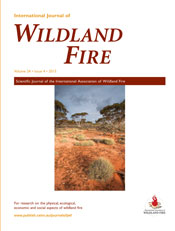International Journal of Wildland Fire
Volume 24
Number 4 2015
We developed a generic fire spread model for shrubland vegetation using experimental fire data from Europe, Africa and Australasia. Independent variables describing fire spread were wind speed, dead fuel moisture, and vegetation height or bulk density. Models were evaluated against prescribed burn and wildfire data with encouraging results.
Infrared radiant emissions from wildland fire pixels were simulated for the purpose of relating total emissions to radiation reaching a collection of limited bandpass sensors. Total radiation was an exponential function of sensor-reaching radiation with acceptable error (<10%) that was least for sensors that responded to mid-wave infrared radiation.
Analysis of the temporal dynamics of wildland fire fuels following high-severity fire revealed the dominant factors influencing fuel inputs in the post-fire environment, as well as linear trends in fuel loadings up to 24 years post fire. This information helps determine how fuels could influence future fire effects, and will aid in developing appropriate fuels management strategies.
Surface fuels are highly heterogeneous in their characteristics and spatial distribution, but knowledge of within-stand variability is generally lacking. This paper examines relationships between fuel loads and overstorey characteristics in a mixed conifer forest, which explained around one-quarter of the variability in fuel loads.
We studied the influence of burn severity and number of burn entries on forests in Grand Canyon National Park. We found second-entry, low-severity burns were effective in reducing white fir densities in the white fir encroachment type whereas high-severity fire was conducive to aspen regeneration in dry mixed conifer forests.
Aleppo pine forests are subjected to frequent wildfires and droughts, which constrain their reproduction and growth. We tested whether female cone production and radial growth were linked in post-fire young Aleppo pines and found that they were positively linked and enhanced by wet conditions and lower tree density.
This study investigated the effectiveness of post-fire seeding in a high-severity burn and the resulting differences between seeded and non-seeded areas. Our results indicate that seeding on the Warm Fire was not effective at significantly increasing vegetation cover to decrease the invasion of non-native plants and reduce erosion.
We correlated post-fire soil colour and environmental characteristics with perennial bunchgrass mortality in sagebrush plant communities. Soil colour and bunchgrass depth of burn were accurate predictors of bunchgrass mortality at individual plant and plant community scales and could be used to determine spatial allocation of post-fire bunchgrass rehabilitation effort.
The response of a shrubland mammal and reptile community to fire history was divergent both within and across taxonomic groups. Fire management that homogenises large areas of habitat through either fire exclusion or frequent burning may threaten species, so careful management of fire may be needed to maximise habitat suitability across the landscape.
Some bat species in the south-eastern USA hibernate below leaf litter during the coldest periods of winter. If bats are unable to escape before the arrival of fire during winter prescribed burns, these fires produce temperatures below leaf litter that are mostly unsurvivable. Burning during the warmer periods of winter (e.g. ≥15°C) and during afternoons could potentially improve survival by reducing arousal and escape times for bats roosting under leaf litter.
Timely information on spatial variation of live fuel moisture is critical for fire risk assessment and behaviour modelling. This study demonstrates the utility of radar systems for live fuel moisture estimation. The estimation accuracy was equivalent to or higher than that obtained using optical-based vegetation indices.
Through field-scale burning experiments, we found that mastication treatments reduced fire behaviour during prescribed burning in pine flatwoods dominated by saw palmetto and gallberry. Recovering shrubs, however, influenced fire behaviour six months following mechanical treatment. Mastication may be effective at reducing fire hazard, but the duration of efficacy is unknown.
Data from the Dutch Creek incident, the Cramer fire and the Panther fire are used to show that ambiguous radio messages can affect the safety of firefighters. Whereas previous research has pointed to technical barriers to effective radio communication, this paper draws attention to the actual wording of messages.




